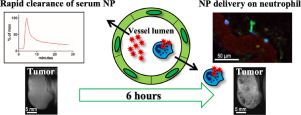当前位置:
X-MOL 学术
›
Acta Biomater.
›
论文详情
Our official English website, www.x-mol.net, welcomes your
feedback! (Note: you will need to create a separate account there.)
Neutrophil-mediated transport is crucial for delivery of short-circulating magnetic nanoparticles to tumors.
Acta Biomaterialia ( IF 9.4 ) Pub Date : 2020-01-13 , DOI: 10.1016/j.actbio.2020.01.011 Victor Naumenko 1 , Aleksey Nikitin 2 , Anastasiia Garanina 3 , Pavel Melnikov 4 , Stepan Vodopyanov 3 , Ksenia Kapitanova 5 , Daria Potashnikova 6 , Daniil Vishnevskiy 4 , Irina Alieva 7 , Artem Ilyasov 3 , Barbara Z Eletskaya 8 , Maxim Abakumov 9 , Vladimir Chekhonin 4 , Alexander Majouga 10
Acta Biomaterialia ( IF 9.4 ) Pub Date : 2020-01-13 , DOI: 10.1016/j.actbio.2020.01.011 Victor Naumenko 1 , Aleksey Nikitin 2 , Anastasiia Garanina 3 , Pavel Melnikov 4 , Stepan Vodopyanov 3 , Ksenia Kapitanova 5 , Daria Potashnikova 6 , Daniil Vishnevskiy 4 , Irina Alieva 7 , Artem Ilyasov 3 , Barbara Z Eletskaya 8 , Maxim Abakumov 9 , Vladimir Chekhonin 4 , Alexander Majouga 10
Affiliation

|
Recently neutrophil-based nanoparticles (NPs) drug delivery systems have gained considerable attention in cancer therapy. Numerous studies have been conducted to identify optimal NPs parameters for passive tumor targeting, while there is a fundamental dearth of knowledge about the factors governing cell-mediated delivery. Here, by using intravital microscopy and magnetic resonance imaging, we describe accumulation dynamics of 140 nm magnetic cubes and clusters in murine breast cancer (4T1) and colon cancer (CT26) models. Notwithstanding rapid clearance from the blood flow, NPs readily accumulated in tumors at later time points. Both NPs types were captured mostly by intravascular neutrophils immediately after injection, and transmigration of NPs-bound neutrophils through the vessel wall was first shown in real-time. A dramatic drop in NPs accumulation upon Ly6G and Gr1 depletion further confirmed the role of neutrophils as a biocarrier for targeting tumors. Of note, for shorter circulating NPs, a cell-dependent delivery route was more impactful, while the accumulation of longer circulating counterpart was less compromised by neutrophil depletion. Neutrophil-mediated transport was also shown to depend on tumor type, with more efficiency noted in neutrophil-rich tumors. Revealing NPs characteristics and host factors influencing the neutrophil-based tumor targeting will help to rationally design drug delivery systems for improved cancer treatment. STATEMENT OF SIGNIFICANCE: Utilizing host cells as trojan horses for delivery nanodrugs to tumor site is a promising approach for cancer therapy. However, it is not clear yet how nanoparticles characteristics and tumor properties affect the efficiency of cell-based nanoparticles transport. Here, we compare neutrophil-based delivery of different-shaped magnetic nanoparticles (cubes and clusters) in two tumor models. The results suggest that neutrophil-mediated route is more impactful for rapidly cleared cubes, than for longer circulating clusters. The efficiency of cell-based accumulation also correlated with the level of neutrophils recruitment to different tumor types. These finding are important for rationale design of nanocarriers and predicting the efficiency of neutrophil-mediated drug delivery between patients and tumor types.
中文翻译:

中性粒细胞介导的转运对于将短循环磁性纳米颗粒输送至肿瘤至关重要。
最近,基于中性粒细胞的纳米颗粒(NPs)药物递送系统在癌症治疗中获得了相当大的关注。已经进行了许多研究来确定用于被动性肿瘤靶向的最佳NPs参数,而对于控制细胞介导的递送的因素尚缺乏基本知识。在这里,通过使用活体显微镜和磁共振成像,我们描述了140 nm磁性立方体和簇在鼠类乳腺癌(4T1)和结肠癌(CT26)模型中的累积动力学。尽管从血流中快速清除,但是NP在随后的时间点容易积聚在肿瘤中。注射后,两种类型的NPs大部分都被血管内中性粒细胞捕获,并且首先实时显示了与NPs结合的中性粒细胞通过血管壁的转运。Ly6G和Gr1耗尽后NP积累的急剧下降进一步证实了嗜中性粒细胞作为靶向肿瘤的生物载体的作用。值得注意的是,对于循环时间较短的NP,细胞依赖性的递送途径更具影响力,而循环时间较长的对应物的积累受嗜中性粒细胞耗竭的影响较小。还显示中性粒细胞介导的转运取决于肿瘤类型,在中性粒细胞丰富的肿瘤中效率更高。揭示NPs特征和影响以中性粒细胞为基础的肿瘤靶向的宿主因素将有助于合理设计药物递送系统,以改善癌症治疗。意义声明:利用宿主细胞作为特洛伊木马将纳米药物递送到肿瘤部位是一种有前途的癌症治疗方法。然而,尚不清楚纳米粒子的特性和肿瘤性质如何影响基于细胞的纳米粒子转运的效率。在这里,我们比较了两种肿瘤模型中基于中性粒细胞的不同形状的磁性纳米颗粒(立方体和簇)的递送。结果表明,中性粒细胞介导的途径对快速清除的立方体的影响要比对较长的循环簇的影响更大。基于细胞的积累的效率还与嗜中性粒细胞募集到不同肿瘤类型的水平相关。这些发现对于纳米载体的基本设计和预测患者与肿瘤类型之间嗜中性粒细胞介导的药物递送的效率非常重要。我们比较了两种肿瘤模型中基于嗜中性粒细胞的不同形状的磁性纳米颗粒(立方体和簇)的递送。结果表明,中性粒细胞介导的途径对快速清除的立方体的影响要比对较长的循环簇的影响更大。基于细胞的积累的效率还与嗜中性粒细胞募集到不同肿瘤类型的水平相关。这些发现对于纳米载体的基本设计和预测患者与肿瘤类型之间嗜中性粒细胞介导的药物递送的效率非常重要。我们比较了两种肿瘤模型中基于嗜中性粒细胞的不同形状的磁性纳米颗粒(立方体和簇)的递送。结果表明,中性粒细胞介导的途径对快速清除的立方体的影响要比对较长的循环簇的影响更大。基于细胞的积累的效率还与嗜中性粒细胞募集到不同肿瘤类型的水平相关。这些发现对于纳米载体的基本设计和预测患者与肿瘤类型之间嗜中性粒细胞介导的药物递送的效率非常重要。
更新日期:2020-01-13
中文翻译:

中性粒细胞介导的转运对于将短循环磁性纳米颗粒输送至肿瘤至关重要。
最近,基于中性粒细胞的纳米颗粒(NPs)药物递送系统在癌症治疗中获得了相当大的关注。已经进行了许多研究来确定用于被动性肿瘤靶向的最佳NPs参数,而对于控制细胞介导的递送的因素尚缺乏基本知识。在这里,通过使用活体显微镜和磁共振成像,我们描述了140 nm磁性立方体和簇在鼠类乳腺癌(4T1)和结肠癌(CT26)模型中的累积动力学。尽管从血流中快速清除,但是NP在随后的时间点容易积聚在肿瘤中。注射后,两种类型的NPs大部分都被血管内中性粒细胞捕获,并且首先实时显示了与NPs结合的中性粒细胞通过血管壁的转运。Ly6G和Gr1耗尽后NP积累的急剧下降进一步证实了嗜中性粒细胞作为靶向肿瘤的生物载体的作用。值得注意的是,对于循环时间较短的NP,细胞依赖性的递送途径更具影响力,而循环时间较长的对应物的积累受嗜中性粒细胞耗竭的影响较小。还显示中性粒细胞介导的转运取决于肿瘤类型,在中性粒细胞丰富的肿瘤中效率更高。揭示NPs特征和影响以中性粒细胞为基础的肿瘤靶向的宿主因素将有助于合理设计药物递送系统,以改善癌症治疗。意义声明:利用宿主细胞作为特洛伊木马将纳米药物递送到肿瘤部位是一种有前途的癌症治疗方法。然而,尚不清楚纳米粒子的特性和肿瘤性质如何影响基于细胞的纳米粒子转运的效率。在这里,我们比较了两种肿瘤模型中基于中性粒细胞的不同形状的磁性纳米颗粒(立方体和簇)的递送。结果表明,中性粒细胞介导的途径对快速清除的立方体的影响要比对较长的循环簇的影响更大。基于细胞的积累的效率还与嗜中性粒细胞募集到不同肿瘤类型的水平相关。这些发现对于纳米载体的基本设计和预测患者与肿瘤类型之间嗜中性粒细胞介导的药物递送的效率非常重要。我们比较了两种肿瘤模型中基于嗜中性粒细胞的不同形状的磁性纳米颗粒(立方体和簇)的递送。结果表明,中性粒细胞介导的途径对快速清除的立方体的影响要比对较长的循环簇的影响更大。基于细胞的积累的效率还与嗜中性粒细胞募集到不同肿瘤类型的水平相关。这些发现对于纳米载体的基本设计和预测患者与肿瘤类型之间嗜中性粒细胞介导的药物递送的效率非常重要。我们比较了两种肿瘤模型中基于嗜中性粒细胞的不同形状的磁性纳米颗粒(立方体和簇)的递送。结果表明,中性粒细胞介导的途径对快速清除的立方体的影响要比对较长的循环簇的影响更大。基于细胞的积累的效率还与嗜中性粒细胞募集到不同肿瘤类型的水平相关。这些发现对于纳米载体的基本设计和预测患者与肿瘤类型之间嗜中性粒细胞介导的药物递送的效率非常重要。











































 京公网安备 11010802027423号
京公网安备 11010802027423号